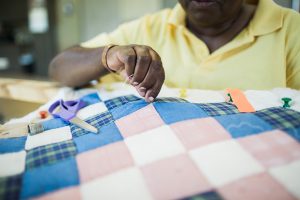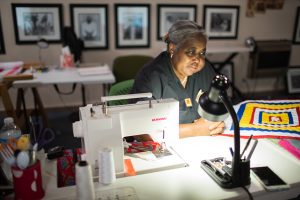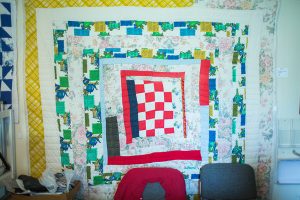“It’s like medicine to me. I suffer with arthritis, but when I’m quilting, I can’t feel the pain,” said Mary Ann Pettway. Sitting in the Gee’s Bend Quilting Collective in Gee’s Bend, Alabama, she selected a long, thin piece of purple fabric, laid it next to a small square of pink and white shapes already sewn together, picked up her scissors and made a quick diagonal cut across the purple strip before sliding it all under the whirring needle of her sewing machine. She kept talking as her hands snatched more bits of fabric. She’d eye them for a moment, then cut and stitch, then do it again, the beginnings of a new quilt growing by the second.
[dropcap letter=”A”]s her fingers flew between tasks and she hummed a bouncy tune that matched the rhythm of the machine, it was clear that her work put a temporary halt on the disease ravaging her joints. But her quilts’ therapeutic effects are passed along. Looking at them, your eyes tracing the haphazard lines of asymmetrical angles and forms, can be mesmerizing and relaxing if you give in to it for even a few moments.The lack of a completely identifiable pattern in most of Mary Ann’s quilts is in keeping with the tradition she is a part of. Extreme individuality and a deviation from classic quilting conventions and arrangements are hallmarks of the quilts made by African-American women starting in the early 20th century (and still going) in Gee’s Bend. Once simple necessities – the quilts were made to be used – today, they’re considered valuable and influential folk art and some of the most important contributions to all American art in the last century. They’ve been featured in multiple fine art museum exhibitions, and some have sold for as much as $20,000 each.

I ask the same question sometimes. What is the difference in ours? We are just putting three layers together. But everyone says it is something in the way we combine our colors. I can’t explain the way I do it. I sure can’t explain the way others do it,” she said. She’s right. There is no one “Gee’s Bend way,” and this fact is the closest thing Gee’s Bend quilts have to a cohesive style.
Gee’s Bend, current population 275, is almost an island, resting in a deep bend of the Alabama River and hemmed in on three sides by its water. It’s in Wilcox County, one of the poorest in the state, and yet is and has always has been rich in culture and community connection. In the mid-20th century, a new ferry that crossed the river cut the trip from Gee’s Bend to Camden (the county seat) down from an hour by car to 15 minutes, giving residents easier access to more of the outside world. But in 1962, the ferry was stopped as a way to suppress the black vote during the tumultuous times of the Civil Rights movement. It was 2006 before ferry service resumed, leaving Gee’s Bend untouched again for almost 50 years. This isolation helped fashion a close-knit society with a distinct culture, a culture vibrantly expressed in the idiosyncratic styles of its women’s quilts.
Now in her early 60s, Mary Ann has always found her quilt designs inside herself. “I mostly do mine out of my head,” she said. “I don’t know what the finished piece is going to look like before I start. I tried drawing one on paper one time beforehand, but it didn’t work out, cause as soon as I start piecing it together, my mind changes.”
Making any quilt starts with composing the top layer in a process called piecing. Some hand-stitch the elements to each other; others do it on a machine. Mary Ann does both. This part can take weeks for a large quilt, but once it’s done, it’s laid over cotton batting and a backing layer, and the quilt stitches are added to bind it all together. These, in Gee’s Bend at least, are always done by hand.

This method results in a wide array of quilts, no two alike, although there is one constant in Mary Ann’s work. “I love triangles,” she said. “All my quilts look different, but I never get tired of adding triangles. Sometimes when I do a quilt, I think ok, I’m just going to do a quilt with squares, with no triangles. I tried that one time, and I couldn’t help myself, I had to put a triangle in there somewhere.”
She laughed long and loud at her triangle obsession, evidence of the joy she derives from quilting. Born and raised in Gee’s Bend, she learned how to piece quilts at age 6, and by 13 was quilting on her own. She took over as manager of the Collective in 2006. Housed in a wooden building with whitewash fading, it was established in 2002 as a place to showcase and sell the quilts made by area ladies and give them a space to work.
Mary Ann can often be found quilting in the front room when visitors arrive, sometimes by the busloads. A side room is lined with shelves stacked to sagging with folded quilts in a rainbow of hues. A few hang on the walls. Also on the walls are black and white photos, the faces of some of Gee’s Bend’s most prolific quilters and their families. Many have the Pettway name, but it doesn’t mean they’re all blood related.
“Pettway was the main slave owner here’s name,” Mary Ann said. “When freed, most of the folks from his plantation just kept his name.” Now, as then, the residents of Gee’s Bend share this slave-descendant history and its thread of connection even if they don’t share genes.
PUTTING IT TOGETHER, TOGETHER
Sometimes, other ladies show up at the Collective to quilt, but most of the older ladies, a generation before Mary Ann, gather at the Gee’s Bend Welcome Center and in the senior center that’s next door. In their late 70s and even late 80s, many of them no longer quilt like they used to (most have lost count of how many quilts they’ve made), but they still meet often to share lunch and news and sometimes, to quilt. They may pull out their thimbles and materials less frequently now, but they still look forward to the companionship. “Visiting was always a lot of the appeal for me,” said Lucy Marie Mingo. The 84-year-old started quilting at 14 and only does it occasionally today. “We’d just chat, maybe gossip some, and talk through what was going on with us.”
Nancy Pettway called her old quilting group of five ladies the “golden girls.” “We’d laugh and sew and laugh,” she said. Rita Mae Pettway chimed in. “When my grandmother and them used to quilt together, and then when we did, we’d do it in groups of four or sometimes six,” she said. “That was just what we did; it was nice to be together and to help each other.
And even though they don’t produce number of quilts they once did, when they’re ready to stitch a quilt’s three layers together, they still do it together. It’s how they learned the craft as young girls. “Almost all of us learned from our mothers and grandmothers,” Rita Mae said. The 76-year-old is a Gee’s Bend native and got her skills from her grandmother, Annie E. Pettway. “She didn’t take time out to teach me really,” she said. “I just watched her, and she’d let me try on small pieces and would tell me what to do or not to. That’s how my daughter learned from me.”

Even if you didn’t grow up in it, if you married into a family with a quilter, you got into it, as Nancy explained. “I came here 1968 from Prairie, AL, to get married, and I had not quilted before that,” she said. “I started watching the other women here; they’d get together and quilt,” she said. “I told them ‘I’ll thread y’all’s needles,’ just so I could be there with them, but one of the old ladies, Alonsia Pettway, said ‘No. If you gonna thread a needle, you gonna sew.’ So I always sat by her, between her and my sister-in-law, and I caught on to quilting watching those two.”
Even when a quilt is finished by a group’s collaborative efforts, the woman who pieced it, who created its look, retains ownership. The quilt is hers. “Back then, they’d go from house to house to quilt,” Rita Mae said. “One woman would have her top done, so the group would come help her beat out the cotton. Now we can get cotton from a bag at the store, but then, we got it from the gin and beat it out with a stick,” she said.
The group would work to get the top, batting, and back on a frame, and then they’d set to adding the quilt stiches. “When they finished with that quilt, they’d go on to the next house,” Rita Mae said.
It’s no easy task now, but it was even harder work decades ago, so much so that some women who grew up doing it gave it up even when they were still physically able to do it. “I started quilting at 13, but I hardly do it all anymore,” Lola Pettway said. “Sometimes I enjoyed it, but sometimes, I really didn’t, if you want to hear the truth. Sometimes it was just tedious, and I’d prick my fingers. When I was young, I had so many sticks from the needle.”

But for others, like Mary Ann, the process of creating a quilt is an escape. “I’ve always liked all of it, every step,” Lucy said. “It relaxes my mind to do it.” They were functional, needed objects, but the making of quilts also provided respite from long, hard, hot days working small farms, fighting with nature and begging it to produce.
Life was difficult then, yet like today, the quilts made in those times show the opposite. They are outbursts of bold color and a wild, free geometry that point to anything but dull, dark routine.
MATERIAL GIRLS
Just as the way Gee’s Bend women make quilts has changed, so too have the materials. “Back years ago, I used mostly what I had on hand,” Rita Mae said. “We all did. When we wore our clothes out, we used that cloth. Sometimes, I’d go to Selma or Thomasville to get some solid cloth and add that in.”
I never bought anything to make no quilt,” Mary Lee Bendolph said. “I used whatever I had, old jeans, dresses, shirts, and the way they turned out was kinda based on that.
This reliance on scraps and recycled clothing often drove the finished appearance of Gee’s Bend quilts, but something else factored in too. Something Rita Mae said, “was just in my head.” “I can see it all finished before I start,” she said. “I know what it should be. I don’t draw it or plan it really. I just do it from my head.”
She made quilts from some patterns in a book once, but she didn’t like them. “My kids didn’t neither,” she said. “When I tell them to go get a quilt for themselves, they never pick those. They want the ones I made from scratch.”
Each lady has colors and techniques they preferred and used often, resulting in the free-form individualism that has become a signature of Gee’s Bend quilts. “All of my quilts were different, but red and white were the colors I used most,” Rita Mae said. Lola opted for pink and yellow, while Nancy favored red, purple and green.
WORLD FAMOUS
It is the Gee’s Bend quilts’ diversity that first appealed to the early collectors, the ones who put the spotlight on the region and its female artists. In the 1960s, the Gee’s Bend quilting tradition got noticed in conjunction with the Freedom Quilting Bee in nearby Alberta. The Bee was formed to draw attention to the fight for civil rights and included a few Gee’s Bend quilters. Some national press about the Bee put Gee’s Bend quilts in the wider public eye for the first time.
Then, in the late 1990s, Atlanta-based art collector and dealer William Arnett stumbled on a photo of a Gee’s Bend quilt and was so moved by what he saw that he traveled to Gee’s Bend to find the quilt and quilter. He found Annie Mae Young and paid her several thousand dollars for the quilt in the picture and a few thousand more for several other quilts. He helped organize the first exhibition of the area’s quilts, which premiered at the Houston Museum of Art in 2002 and then traveled the country. A second exhibition toured the United States in 2006 and 2007, and a Gee’s Bend quilt is part of the permanent collection at the Smithsonian’s newly opened National Museum of African American History & Culture. In 2006, the U.S. Post Office issued 10 Gee’s Bend commemorative stamps. Sixteen Gee’s Bend quilters created a quilt for President Obama.

Mary Lee remembers when Arnett, and then the others that followed, came to Gee’s Bend. “It was special, those people visiting us then,” she said. “It meant something to see folks get so excited by our quilts.”
Rita Mae echoed Mary Lee. “They’ve always been beautiful to me, all of the quilts from here, but especially the ones I made with my hands,” she said. “Of course I like that others see them as beautiful too.”
So many, like Mary Lee, whose several strokes have put an end to her quilting, are slowing down or stopping. But the international interest the quilts have garnered in the last 20 years has re-invigorated interest at home too, spurring a new generation to start quilting again, or take it up for the very first time.
Doris Pettway Mosely, daughter of one of Gee’s Bend’s most famous quilters, Leola Pettway, didn’t start quilting on her own until 2008 when she started working at the welcome center, where she also quilts, in 2012. “I helped my mom a bit, but I didn’t care that much about it until later in my life,” she said. “I like the attention when people come here and they like to watch me work, but I feel really great about my mom and them finally getting recognized for what they created. As they got older, it was really just what they did to pass the time, but it was their way to put something of themselves out there too, their art.”

If you ask the ladies if their quilts are art, they acknowledge that they are, but some seem hesitant. “I now think my quilts are art. I didn’t always, but that’s cause I didn’t know anything about art,” Mary Ann said. “I had someone come here and say, ‘Oh you are a true artist.’ I said, ‘Well, thank you.’ It is gift God blessed me with, and I just use it to the best of my ability.”
She also believes the attention on the quilts has been positive for Gee’s Bend. “Some people here seem like they don’t care about it, but it has been good for the place,” she said. “It’s different now though. My mom made hers to have something to put on the bed. I make my quilts to sell. I enjoy knowing that people love my work and want it.”
Written by Jennifer Kornegay / Photography by Ashleigh Coleman
SaveSave
